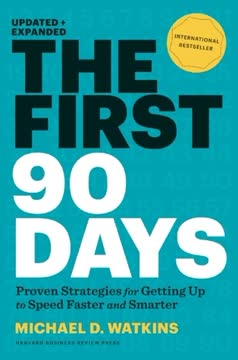Key Takeaways
1. Exponential Change is the New Normal: Adapt or Die
Current technology, though, has changed how evolution takes place, and we are now witnessing exponential change.
The new reality. The world no longer operates on linear, predictable progress. Thanks to digital transformation, artificial intelligence, and interconnected technologies, change is exponential, accelerating at an unimaginable pace. Companies that once dominated, like Kodak, failed because they applied linear thinking to an exponentially evolving market, underestimating the speed and impact of digitalization.
The Six Ds of Exponentials. This rapid evolution follows a predictable pattern:
- Digitalization: Processes move from physical to digital (ones and zeros).
- Deception: Initial growth appears linear and slow, misleading traditional management.
- Disruption: Sudden, explosive growth catches competitors off guard.
- Demonetization: Products become free or significantly cheaper.
- Dematerialization: Products integrate into other devices (e.g., camera into a phone).
- Democratization: Technology becomes universally accessible.
Counterintuitive nature. Our brains are biologically wired for linear progression, making it difficult to intuitively grasp exponential growth. This inherent bias means traditional business practices and decision-making models are often ill-equipped to handle the volatility and uncertainty of today's markets, necessitating a fundamental shift in mindset and operational approach.
2. Organizational Health is the Foundation for Adaptation
Today, competitive advantage doesn’t go to the company with the best widget. It goes to the organization that can reinvent itself and defend itself from attackers—wherever they may come from—better than anyone else.
Beyond products. In an era of relentless change, a company's true competitive edge lies not just in its products, but in its ability to continuously reinvent itself. This requires a healthy organization where people feel confident, collaborate effectively, and view conflict as an opportunity for improvement, rather than a threat. Without this foundational health, any transformation initiative is likely to fail.
Conflict as a tool. Organizational health is deeply intertwined with how conflict is managed. The Runde and Flanagan model identifies five levels of conflict:
- Differences: Diverse viewpoints, seen as positive.
- Misunderstandings: Lack of transparency, easily resolved with clear communication.
- Disagreements: Different positions, can be productive if approached as improvement opportunities.
- Discord: Adverse interpersonal effects, criticism, avoidance.
- Polarization: Opponents recruit allies, focus on winning at all costs.
The first three levels can be highly productive, fostering innovation and growth, while the latter two are dysfunctional and erode trust.
Empirical learning. A healthy organization embraces empiricism, where knowledge comes from working experience. This involves three pillars:
- Transparency: All aspects of processes are visible and understood by everyone.
- Inspection: Processes are frequently reviewed to detect variations and surprises.
- Adaptation: Improvements are made based on inspections, fostering continuous evolution.
This iterative approach allows companies to learn rapidly, adjust strategies, and build resilience in the face of unpredictable market shifts.
3. Change is Complex, Not Just Complicated
A change within a company is a complex problem, and to solve it you need to think differently.
Distinguishing problems. Many leaders mistakenly treat complex problems as if they were merely complicated. A complicated problem has a definitive, correct solution, even if it's hard to find (e.g., calculating brick needs for a wall). A complex problem, however, has no single correct solution, involves illogical elements, multiple conflicting viewpoints, and a high human factor influenced by emotions and culture.
The trap of tools. Applying "complicated" solutions (like new software tools or rigid processes) to "complex" human and cultural problems often exacerbates issues rather than solving them. This "seduction of tools" distracts from the underlying human factors, leading to increased bureaucracy, inefficiency, and a false sense of progress. True transformation requires addressing the intricate web of human interactions and behaviors.
Beyond simple loops. Traditional "simple loop" decision processes—where executives decide, communicate, implement, and measure—are insufficient for complex environments. This linear thinking, inherited from the industrial era, ignores emotions, collective intelligence, and social patterns. It leads to unsustainable behaviors and a lack of genuine commitment, as people are told what to do rather than empowered to co-create solutions.
4. Overcome Resistance by Understanding the Brain
Our rational brain is equipped with evolutionary neurological mechanisms that aren’t particularly advanced, and information that differs from our personal beliefs is perceived as a threat.
Confirmation bias. Humans are not inherently rational; our brains are wired to seek information that confirms pre-existing beliefs, a phenomenon known as confirmation bias. When confronted with contradictory information, the mind often finds fault or inconsistency rather than adapting, leading to resistance to change. Overcoming this requires reframing questions to challenge assumptions and encourage diverse perspectives.
The amygdala's role. The amygdala, the brain's "smoke detector," activates rapidly in response to perceived threats, whether physical or symbolic (like changes in role or status). This activation floods the brain with stress hormones, hindering the prefrontal cortex (the thinking brain) and leading to irrational resistance, fear, and paralysis. Leaders must create safe environments and explicitly address fears to mitigate this biological response.
Micro-habits for change. To counter the brain's resistance, focus on micro-habits: small, effortless actions that require minimal motivation. These leverage the "behavioral impulse" or virtuous cycle, where small positive changes lead to more. For example, instead of a full workout, commit to putting on gym shoes. This builds momentum and strengthens new neural connections, making larger changes more achievable and sustainable over time.
5. Drive Contagious Change with CREEP Patterns
You need to plant a different seed, one that makes it possible to evolve how teams reason, resolve conflict, take responsibility for tasks, view different expectations, and embrace other attitudes for turning the organization into a remarkable place.
Beyond motivation. While autonomy, mastery, and purpose are crucial for individual motivation, they alone won't make change contagious across an organization. To achieve widespread, self-sustaining transformation, leaders must focus on five interconnected areas, collectively known as CREEP:
- Conflict Resolution
- Reframing Mindset
- Exponential Strategy
- Expectations and Alignment
- Psychological Ownership
Reframing reality. Reframing techniques are vital for shifting perspectives and fostering neuroplasticity. Unlike brainstorming, which generates ideas within existing mental models, reframing forces individuals to adopt entirely new viewpoints (e.g., "Robinson Crusoe" or "Perceptual Position" techniques). This "reboots" the mind, allowing for innovative solutions and a more adaptive response to emotionally charged situations, by changing how memories are recalled and decisions are made.
Psychological ownership. When individuals invest time, effort, and creativity, they develop psychological ownership over their work, even if it's not legally theirs. This boosts commitment, motivation, and quality. However, it can also lead to resistance if beloved creations are discarded. Leaders must foster fairness, community, and participation to encourage positive ownership, and create systematic, transparent ways for employees to detach from past work when necessary.
6. Build a Powerful Vision and Empower a Transformation Team
Your vision of change can motivate people to modify a specific area of the company (software development, marketing, human resources, etc.) or the processes of the entire company.
The guiding star. Every successful transformation begins with a powerful, explicit vision of change. This vision must be easy to understand, emotionally appealing, and constantly reinforced by leaders. It acts as a guiding star, aligning everyone towards a better future and diminishing uncertainty, which in turn fosters positive psychological attitudes and reduces the fear of failure.
Sense of urgency. A genuine sense of urgency is critical for sustaining change. This isn't about arbitrary deadlines, but about recognizing real external pressures (market shifts, competition, client demands) and the economic consequences of inaction. When employees perceive a clear, shared urgency, they become energized and actively drive the transformation, rather than passively waiting for instructions.
The Transformation Team. For large-scale change, a dedicated Transformation Team is essential. Comprising 3-5 members per 100 affected individuals, these teams need strong mediation skills, respect within the organization, and the power to remove obstacles. Their role is to:
- Improve transparency and reinforce the change message.
- Help unlearn old practices and teach new ones.
- Facilitate connections and self-organization.
- Ensure necessary operational alterations.
- Support new capabilities and manage logistics.
This team acts as the engine of change, fostering collaboration and continuous improvement across the organization.
7. Leverage Enterprise Social Systems for Sustainable Transformation
Enterprise Social Systems was designed with digital companies in mind. Its main objective is to help leaders, change agents, and coaches to create new frameworks, methodologies, or processes that accelerate change in the company, allowing it to turn exponential.
Beyond Agile. While Agile and Scrum revolutionized IT, transforming an entire organization requires moving beyond departmental methodologies to "Business Agility." This means focusing on organizational design, governance, and culture across all functions, not just software development. The goal is to create new ways of working that challenge existing beliefs and alter people's fundamental patterns and behaviors throughout the company.
The four pillars. Enterprise Social Systems (ESS) provides a conceptual model of an organization as four interdependent pillars, with the center having the greatest impact:
- Social Systems: The core, representing communication, interactions, habits, and informal rules.
- Mindset: Beliefs, values, and abstract ideas forming the company's culture.
- Formal Organization: Structures, information systems, and control mechanisms.
- Value Creation: The external layer, focusing on delivering value to the client through frameworks and methodologies.
Any change in the inner pillars (especially Social Systems) profoundly affects the outer ones, highlighting the importance of human-centric transformation.
Holistic approach. ESS offers a holistic approach to change, recognizing that simply implementing new tools or processes (often a "seduction of tools") is insufficient. It emphasizes understanding how knowledge flows, how people learn, react to change, and resolve conflict. By addressing these human and cultural factors, ESS helps create powerful plans that impact all four pillars, enabling the organization to truly become exponential.
8. Master the Five ESS Components to Accelerate Change
During the challenge time, Enterprise Social Systems offers five components so different forms of reasoning can be employed to maximize creativity and the impact of the change.
New ways of thinking. During periods of challenge and transformation, traditional companies often revert to old, linear reasoning. Enterprise Social Systems introduces five key components to foster new mental processes, maximize creativity, and accelerate change:
- Enterprise Blocking Collaboration: Identifying and reducing negative cooperation that hinders workflow (e.g., multitasking, local optimizations).
- Enterprise Social Density: Increasing the flow of relevant, honest, informal information through direct communication and trust.
- Permission-to-learn Pattern: Eliminating bureaucratic hurdles to learning, empowering employees to acquire skills proactively.
- Enterprise Social Visibility: Maximizing knowledge passively gained from the physical environment (e.g., information radiators, visible interactions).
- Complexity and Complication Pattern: Reducing unnecessary processes, rules, and bureaucracy that stifle adaptation and innovation.
Blocking Collaboration. This component focuses on identifying and eliminating "negative" cooperation that actually impedes progress. Examples include:
- Employees taking on new tasks when already at high capacity.
- Solving problems by adding more rules or local optimizations.
- Teams communicating solely via email instead of face-to-face.
- High multitasking and unnecessary reporting.
Reducing these behaviors is crucial for improving workflow and delivering business value.
Social Density and Visibility. High Enterprise Social Density (ESD) means relevant, informal information flows quickly and effectively. This is fostered by face-to-face communication, direct access to colleagues, and reduced bureaucracy. Enterprise Social Visibility (ESV) complements this by ensuring knowledge is passively captured from the environment through:
- Public information radiators (boards, screens).
- Visible social interactions and facial expressions.
- Visualization of actions and movements.
- Physical space aligned with value creation.
Together, ESD and ESV create an environment where knowledge spreads organically, accelerating learning and adaptation.
Permission-to-learn and Complication. The Permission-to-learn pattern highlights the detrimental effect of requiring formal approvals for learning. Companies must empower employees to self-organize around learning needs, fostering continuous skill development through informal channels and hands-on experience. The Complexity and Complication pattern addresses the tendency to add more processes and bureaucracy in response to new requirements. Simplifying structures, promoting self-organization, and actively removing obstacles are key to reducing complication and increasing adaptability.
9. Choose the Right Framework: ELSA for Supported Change, DeLTA for Grassroots
ELSA uses shortcuts in the brain to accelerate the speed of transformation, while DeLTA supports change and makes it contagious by using habits that already exist in traditional companies.
Tailored transformation. Not all change initiatives have the same level of leadership support. Enterprise Social Systems offers two distinct frameworks to cater to these different scenarios:
- ELSA (Event, Language, Structures, Agency): Designed for situations where organizational leaders and sponsors actively support the transformation.
- DeLTA (Double Loop for Transforming & Accelerating): Ideal for grassroots initiatives where explicit leadership commitment is not yet present.
ELSA's power. ELSA leverages insights from neuroscience and psychology, particularly the impact of language on thought and behavior. By carefully crafting messages and using specific linguistic structures (e.g., present tense, "hypothesis" instead of "requirement"), ELSA aims to create "shortcuts in the brain" that accelerate the adoption of new ideas and habits. It focuses on amplifying the change message and enabling people to take ownership of new concepts, making the transformation exponential.
DeLTA's approach. DeLTA, on the other hand, focuses on making change contagious even without top-down mandate. It works by identifying and subtly modifying existing habits within traditional company structures. While it may not achieve the same rapid acceleration as ELSA, DeLTA provides a practical pathway for individuals or small groups to initiate and spread positive change, building momentum and demonstrating value until broader organizational support can be garnered.
Last updated:
Review Summary
Leading Exponential Change offers insights on managing transformation and embracing change in organizations. Readers appreciate its comprehensive coverage of topics relevant to change management and Agile transformation. However, some find it lacks depth in certain areas. The book introduces unique models like ELSA and DELTA for organic change. Reviewers value its refreshing ideas and practical recommendations for dealing with resistance. While some appreciate the diverse concepts presented, others note that deeper exploration of topics can be found in other specialized books. Overall, it's considered a useful reference for change consultants and Agile practitioners.
Similar Books
Download PDF
Download EPUB
.epub digital book format is ideal for reading ebooks on phones, tablets, and e-readers.







